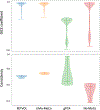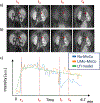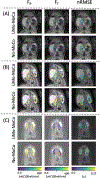Modeling dynamic radial contrast enhanced MRI with linear time invariant systems for motion correction in quantitative assessment of kidney function
- PMID: 33147561
- PMCID: PMC7735437
- DOI: 10.1016/j.media.2020.101880
Modeling dynamic radial contrast enhanced MRI with linear time invariant systems for motion correction in quantitative assessment of kidney function
Abstract
Early identification of kidney function deterioration is essential to determine which newborn patients with congenital kidney disease should be considered for surgical intervention as opposed to observation. Kidney function can be measured by fitting a tracer kinetic (TK) model onto a series of Dynamic Contrast Enhanced (DCE) MR images and estimating the filtration rate parameter from the model. Unfortunately, breathing and large bulk motion events due to patient movement in the scanner create outliers and misalignments that introduce large errors in the TK model parameter estimates even when using a motion-robust dynamic radial VIBE sequence for DCE-MR imaging. The misalignments between the series of volumes are difficult to correct using standard registration due to 1) the large differences in geometry and contrast between volumes of the dynamic sequence and 2) the requirement of fast dynamic imaging to achieve high temporal resolution and motion deteriorates image quality. These difficulties reduce the accuracy and stability of registration over the dynamic sequence. An alternative registration approach is to generate noise and motion free templates of the original data from the TK model and use them to register each volume to its contrast-matched template. However, the TK models used to characterize DCE-MRI are tissue specific, non-linear and sensitive to the same motion and sampling artifacts that hinder registration in the first place. Hence, these can only be applied to register accurately pre-segmented regions of interest, such as kidneys, and might converge to local minima under the presence of large artifacts. Here we introduce a novel linear time invariant (LTI) model to characterize DCE-MR data for different tissue types within a volume. We approximate the LTI model as a sparse sum of first order LTI functions to introduce robustness to motion and sampling artifacts. Hence, this model is well suited for registration of the entire field of view of DCE-MR data with artifacts and outliers. We incorporate this LTI model into a registration framework and evaluate it on both synthetic data and data from 20 children. For each subject, we reconstructed the sequence of DCE-MR images, detected corrupted volumes acquired during motion, aligned the sequence of volumes and recovered the corrupted volumes using the LTI model. The results show that our approach correctly aligned the volumes, provided the most stable registration in time and improved the tracer kinetic model fit.
Keywords: Dynamic contrast enhanced MRI; Model based registration; Motion compensation; Quantitative MRI.
Copyright © 2020 Elsevier B.V. All rights reserved.
Conflict of interest statement
Declaration of Competing Interest The authors declare that they have no known competing financial interests or personal relationships that could have appeared to influence the work reported in this paper.
Figures










Similar articles
-
Motion-compensated image reconstruction for improved kidney function assessment using dynamic contrast-enhanced MRI.NMR Biomed. 2024 Jun;37(6):e5116. doi: 10.1002/nbm.5116. Epub 2024 Feb 15. NMR Biomed. 2024. PMID: 38359842 Free PMC article.
-
Linear Time Invariant Model based Motion Correction (LiMo-MoCo) of Dynamic Radial Contrast Enhanced MRI.Med Image Comput Comput Assist Interv. 2019 Oct;11765:430-437. doi: 10.1007/978-3-030-32245-8_48. Epub 2019 Oct 10. Med Image Comput Comput Assist Interv. 2019. PMID: 32483560 Free PMC article.
-
Bulk motion-compensated DCE-MRI for functional imaging of kidneys in newborns.J Magn Reson Imaging. 2020 Jul;52(1):207-216. doi: 10.1002/jmri.27021. Epub 2019 Dec 14. J Magn Reson Imaging. 2020. PMID: 31837071 Free PMC article.
-
Image registration in dynamic renal MRI-current status and prospects.MAGMA. 2020 Feb;33(1):33-48. doi: 10.1007/s10334-019-00782-y. Epub 2019 Oct 9. MAGMA. 2020. PMID: 31598799 Free PMC article. Review.
-
Tracer-kinetic modeling of dynamic contrast-enhanced MRI and CT: a primer.J Pharmacokinet Pharmacodyn. 2013 Jun;40(3):281-300. doi: 10.1007/s10928-013-9315-3. Epub 2013 Apr 6. J Pharmacokinet Pharmacodyn. 2013. PMID: 23563847 Review.
Cited by
-
Motion-compensated image reconstruction for improved kidney function assessment using dynamic contrast-enhanced MRI.NMR Biomed. 2024 Jun;37(6):e5116. doi: 10.1002/nbm.5116. Epub 2024 Feb 15. NMR Biomed. 2024. PMID: 38359842 Free PMC article.
-
Motion correction of free-breathing magnetic resonance renography using model-driven registration.MAGMA. 2021 Dec;34(6):805-822. doi: 10.1007/s10334-021-00936-x. Epub 2021 Jun 23. MAGMA. 2021. PMID: 34160718 Free PMC article.
-
Quantitative renal magnetic resonance imaging: magnetic resonance urography.Pediatr Radiol. 2022 Feb;52(2):228-248. doi: 10.1007/s00247-021-05264-9. Epub 2022 Jan 13. Pediatr Radiol. 2022. PMID: 35022851 Free PMC article. Review.
-
Learning the Regularization in DCE-MR Image Reconstruction for Functional Imaging of Kidneys.IEEE Access. 2022;10:4102-4111. doi: 10.1109/access.2021.3139854. Epub 2021 Dec 30. IEEE Access. 2022. PMID: 35929000 Free PMC article.
-
Manifold-based respiratory phase estimation enables motion and distortion correction of free-breathing cardiac diffusion tensor MRI.Magn Reson Med. 2022 Jan;87(1):474-487. doi: 10.1002/mrm.28972. Epub 2021 Aug 13. Magn Reson Med. 2022. PMID: 34390021 Free PMC article.
References
-
- Block KT, Chandarana H, Milla S, Bruno M, Mulholland T, Fatterpekar G, Hagiwara M, Grimm R, Geppert C, Kiefer B, Sodickson DK, 2014. Towards routine clinical use of radial stack-of-Stars 3D gradient-echo sequences for reducing motion sensitivity. Journal of the Korean Society of Magnetic Resonance in Medicine 18 (2), 87 10.13104/jksmrm.2014.18.2.87. - DOI
-
- Buonaccorsi GA, Roberts C, Cheung S, Watson Y, Davies K, Jackson A, Jayson GC, Parker GJ, 2005. Tracer kinetic model-driven registration for dynamic contrast enhanced MRI time series. In: Lecture Notes in Computer Science (including subseries Lecture Notes in Artificial Intelligence and Lecture Notes in Bioinformatics), 3749 LNCS, pp. 91–98. 10.1007/11566465_12. - DOI - PubMed
-
- Buonaccorsi GA, Roberts C, Cheung S, Watson Y, O’Connor JP, Davies K, Jackson A, Jayson GC, Parker GJ, 2006. Comparison of the performance of tracer kinetic model-driven registration for dynamic contrast enhanced MRI using different models of contrast enhancement. Acad Radiol 13 (9), 1112–1123. 10.1016/j.acra.2006.05.016. - DOI - PubMed
Publication types
MeSH terms
Substances
Grants and funding
LinkOut - more resources
Full Text Sources
Other Literature Sources
Medical

